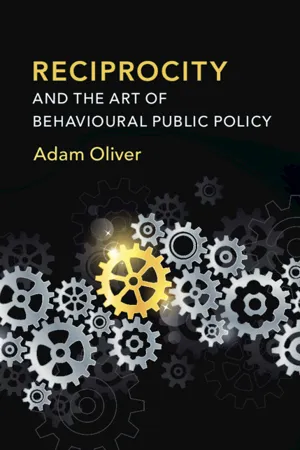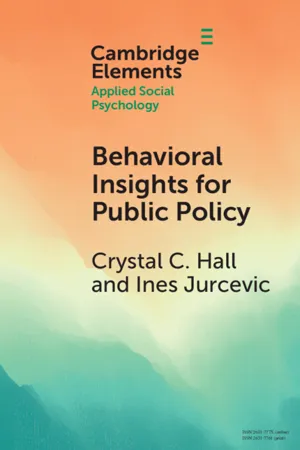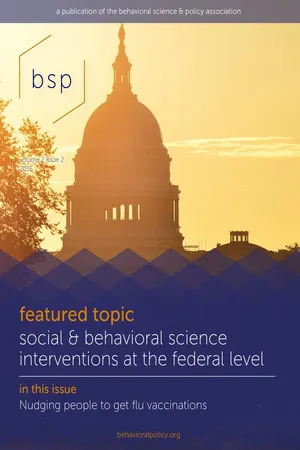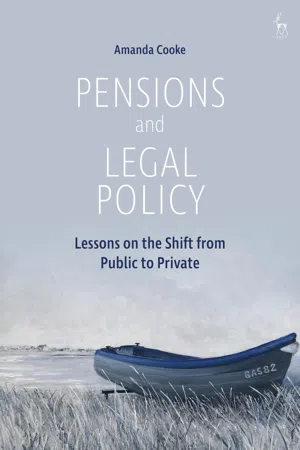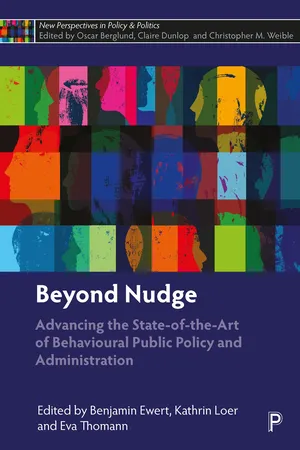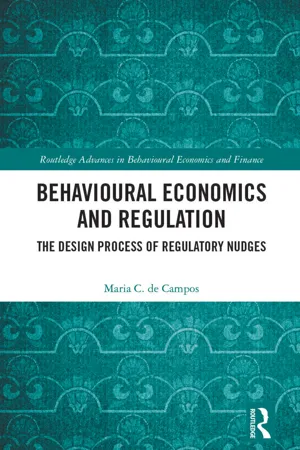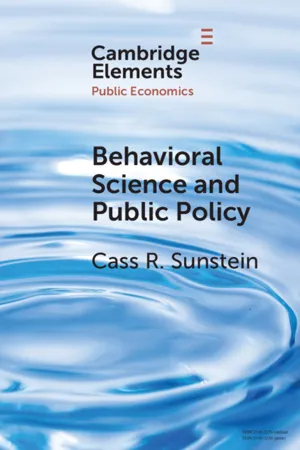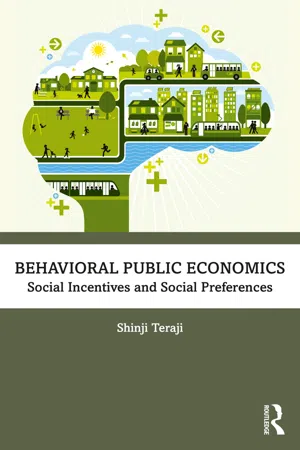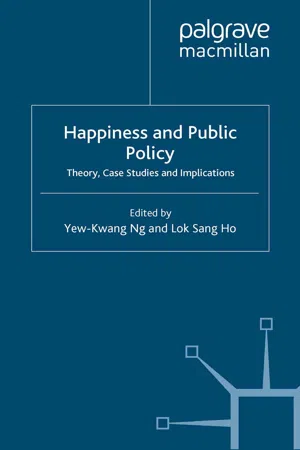Economics
Behavioural Economics and Public Policy
Behavioural economics and public policy examines how insights from psychology and behavioural economics can be applied to improve public policy. It focuses on understanding how individuals make decisions and how policies can be designed to account for these behavioural biases. By incorporating these insights, policymakers can create more effective and impactful interventions.
Written by Perlego with AI-assistance
Related key terms
1 of 5
12 Key excerpts on "Behavioural Economics and Public Policy"
- Adam Oliver(Author)
- 2019(Publication Date)
- Cambridge University Press(Publisher)
9 Towards a Political Economy of Behavioural Public Policy The application of behavioural insights to public policy design – defined here as behavioural public policy – is, in any specific and substantive sense, a relatively recent endeavour, although decades of social science scholarship underpins the approach. 1 Several conceptual frameworks have been developed within the field of behavioural public policy – some, for example, retain the notion of liberty while others allow heavy regulation and even bans; some focus on reducing harms to, and improving benefits for, those that the interventions target specifi- cally while others focus more on reducing harms to other parties; and some aim to influence automatic, reflexive choices while others seek to encourage people to engage in more reflective deliberation. Whichever framework one adopts, however, reciprocity, as a fundamental motiva- tor of individual behaviour, has an important role to play. In this chapter, I will argue that the dominant framework in behavioural public policy to date is that which focuses upon internal- ities – i.e. that which aims to change the behaviour of those targeted for their own benefit – and where the normative goal is to improve welfare, utility or happiness, epitomised by the libertarian paternal- ism, or nudge, approach (Thaler and Sunstein, 2003; 2008). Some of the people whom I respect the most in the areas in which I work, including Luc Bovens, Gus O’Donnell and Cass Sunstein, adhere to this approach, 2 but for me, this is not the principal normative approach – the political economic framework – that should shape the field. In short, and in general, I am sceptical as to whether policy makers 1 My take on the history and development of behavioural public policy can be read within the pages of Oliver (2017). To reiterate from Chapter 5, footnote 11, other quite recent related book-length surveys include those by Nobel Laureates Daniel Kahneman (2011) and Richard Thaler (2015).- eBook - PDF
Behavioral Insights for Public Policy
Contextualizing our Science
- Crystal C. Hall, Ines Jurcevic(Authors)
- 2022(Publication Date)
- Cambridge University Press(Publisher)
This section has provided evidence of the rapid rise and celebration of behavioral science (namely, psychology and behavioral economics) as a way to make governments more effective and efficient. These approaches to policy design, implementation, and evaluation continue to be explored by scholars, practitioners, and policymakers. For example, recent papers in the area of Public Management present an argument about nudging specifically for public policy and governance issues, and how governments use these tools for com- munication with their stakeholders (Esmark, 2019; Ewert, 2020). Next, we explore some examples of successes and challenges in the application of behavioral insights to public policy over the years. 3 Behavioral Insights: Successes and Shortcomings While the majority of behavioral insights applications have produced small and limited effects, several examples of highly salient and publicized large impact, low-cost interventions have motivated the wide deployment of behavioral insights to public policy. Indeed, behavioral insights have proven successful in improving outcomes in a diverse set of policy areas, including environmental and health domains. 3.1 Interventions in Environment Policy There has been much discussion of the role that behavioral science can play in the development and implementation of energy policy (Allcott & Mullainathan, 2010). Behavioral economics has often been used to create “paternalistic” policies to encourage energy efficiency (Allcott, 2016). The impacts of inter- ventions in this space have been complex but compelling (Allcott & Rogers, 2014). The well-known Opower program provides an excellent case study. Opower was a company founded by two Harvard University graduates with the goal of engaging utility customers in the understanding of their energy use. Their initial service involved the creation of highly detailed home-energy 13 Behavioral Insights for Public Policy - No longer available |Learn more
- Craig Fox, Sim B. Sitkin(Authors)
- 2017(Publication Date)
- Brookings Institution Press(Publisher)
Thus, although greater attention has been given in recent years to the use of behavioral science in developing policy, in many ways, injecting the current understanding of human behavior into policy is old hat. Over the past several decades, behavioral scientists have developed a framework for understanding human behavior as it relates to the economy, with an emphasis on the various mental shortcuts that individuals take in actual economic decisionmaking. 1 Policymakers have examined these behavioral insights to better explain why the overall economy might not function as expected under standard economic theory. For example, the finding that setting defaults was a powerful way to overcome the often myopic or shortsighted decisions that individuals make with regard to saving for retire-ment helped motivate legislation like the Pension Protection Act of 2006, signed into law by Pres-ident George W. Bush, which made it easier for companies to adopt automatic enrollment as a feature of their retirement plans. 2 Furthermore, insights from behavioral science literature can help inform assessments of the costs and benefits of policies that are not themselves explicitly behavioral. In setting fuel economy standards—a policy mandate rather than an attempt to assign a default or shape behavior—policymakers should take into account the extent to which consumers, when purchasing a vehicle, are affected by the framing of information or the weighing of present costs that are certain against future benefits that are uncertain. 3 Starting With Behavioral Tools & Looking for Problems To date, most of the integration of behavioral science into public policy has proceeded from developing a set of tools to then searching for problems these tools can help solve. - eBook - PDF
Nudge and the Law
A European Perspective
- Alberto Alemanno, Anne-Lise Sibony(Authors)
- 2015(Publication Date)
- Hart Publishing(Publisher)
44 See, eg C Jolls et al, ‘A Behavioural Approach to Law and Economics’ (1998) 50 Stanford Law Review 1471; C Jolls, ‘Governing America: The Emergence of Behavioural Law and Economics’ Max Weber Lecture Series, 2010/3; R Bubb and R Pildes,‘How Behavioral Economics Trims Its Sails and Why’ (2014) 127 Harvard Law Review 1593. In the EU context: H Luth, Behavioural Economics in Consumer Policy: The Economic Analysis of Standard Terms in Consumer Contracts Revisited (Antwerpen, Intersen-tia, 2010); M Lissowska, ‘Overview of Behavioural Economics Elements in the OECD Consumer Policy Toolkit’ (2011) 34 Journal of Consumer Policy 393; P Lunn (n 4). A European Perspective 9 economics. The publicity was worth the irony. It is indeed a little ironic that, after having embraced the rationality hypothesis for about five decades as a matter of disciplinary identity, economics should appear as the discipline that brings behav-ioural wisdom to the study of law. As Daniel Kahneman writes, ‘Labels matter, and the mislabelling of applied behavioural sciences as behavioural economics has consequences’. 45 The consequences Kahneman points to are, first, that ‘impor-tant contributions of psychology to public policy are not recognized as such’ and, second, that this unfairness drives young psychologists away from applied research that could be useful to policy-making. 46 From a legal scholar’s perspective, this state of affairs is regrettable because it makes more sense to draw directly from empirical psychology studies rather than to take the detour via the selection of psychological insights labelled behavioural economics. It amounts to using a filter that was designed to retain what psychol-ogy could offer to a discussion internal to the discipline of economics, when there is no reason to believe that this filter is suited to legal needs. - eBook - PDF
Pensions and Legal Policy
Lessons on the Shift from Public to Private
- Amanda Cooke(Author)
- 2021(Publication Date)
- Hart Publishing(Publisher)
If consumers are presented with choices in different ways or are encouraged to actively choose then this may counter some of these biases. Individuals may further complicate matters by operating under their own system of norms or heuristics, where the most famil-iar or unambiguous option is preferred. III. The Influence of Behavioural Economics on Law and Policy In the UK a Behavioural Insights Team was established to ‘find intelligent ways to encourage, support and enable people to make better choices for themselves’, 23 which signals the influence of behavioural economics on law and policy in the UK. 24 It is also noteworthy that one of the first actions of the new Financial Conduct Authority was to commission an occasional paper on behavioural economics, 25 which further demonstrates the influence of the work on policy and financial regulation building on previous work of the FSA. 26 The paper sets out the benefits of developing an understanding of the predictable departures from previ-ously accepted behavioural norms and the potential for using these predictions in future regulation. 27 This follows the influence of New Zealand which introduced the KiwiSaver plan in 2007, with the aim of encouraging the long-term savings habits of those who would otherwise suffer a reduction in living standards post retirement. 28 The work is also evident in the revamp of the Australian system and design of MySuper default funds which acknowledges that individuals often stay with default positions even to their detriment. The original system was predicated on the assumption that Superannuation members should be treated as rational and informed investors, with disclosure and market conduct controls being the main regulatory instruments. However, the Cooper Review found that in a compulsory system this also required member interest which was often lacking. When poor financial literacy is added to this the role of defaults becomes much stronger. - eBook - ePub
Beyond Nudge
Advancing the State-of-the-Art of Behavioural Public Policy and Administration
- Benjamin Ewert, Kathrin Loer, Eva Thomann, Benjamin Ewert, Kathrin Loer, Eva Thomann(Authors)
- 2023(Publication Date)
- Policy Press(Publisher)
The chapter is structured as follows: the second section brings together findings on the global expansion and the varieties of behavioural expertise and public policy. The third section introduces the theoretical elements of both concepts of collective policy agency and summarises my core argument. A fourth section applies both concepts on the case of the global behavioural movement and shows that on a first view behavioural expertise and public policy seem indeed to oscillate between both modes of collective agency. The fifth section presents a more time-sensitive interpretation by arguing that there was a gradual shift from one mode of collective agency to the other (‘agency shift’) caused by self-undermining dynamics of the early epistemic community of behavioural experts. In a corresponding move, experimental practices of testing behavioural tools helped to co-constitute and authorise a highly diverse instrument constituency on a global scale. The final section summarises the findings and discusses the implications in the broader context of the debate on collective agency in public policy.Varieties of behavioural expertise and public policy: beyond ‘cookie cutter explanations’
Behavioural public policy as understood here includes all means and modes of public policy aiming at influencing individual behaviour by using insights from behavioural economics, behavioural sciences, psychology or neurosciences. ‘Nudging’ describes only a specific set of techniques by which cognitive heuristics and biases are targeted to change people’s behaviour (Guldborg-Hansen, 2019 ). The close entanglement of science and policy is a common feature of all behavioural public policies. Expertise is an essential resource for governing as it is supposed to establish and provide the scientific evidence for the behavioural change agenda.Beyond this common denominator, however, the landscape of behavioural public policy is extremely diverse. Over the past ten years, the global expansion of organisations and networks has been remarkable (John, 2018 ; Straßheim and Beck, 2019 ; Whitehead et al, 2019 ). Worldwide, more than 80 expert teams and their networks in more than 60 countries are translating insights from behavioural sciences into policy interventions. Transnational organisations such as the World Bank, the European Commission and the United Nations are using behavioural insights across a large and diverse spectrum of policy areas such as development, food safety, health, climate change, migration, gender mainstreaming or anti-corruption policy. In the United Kingdom, the rise of behavioural public policy is associated with the creation of the Behavioural Insights Team (BIT) by David Cameron in 2010, an organisation that has gained both national and international influence by experimentally developing and disseminating behavioural interventions (Jones et al, 2013 ; Ball and Head, 2020 ; Mukherjee and Giest, 2020 - eBook - ePub
Emotional States
Sites and spaces of affective governance
- Eleanor Jupp, Jessica Pykett, Fiona M. Smith(Authors)
- 2016(Publication Date)
- Routledge(Publisher)
These efforts have been informed by research findings from the disciplines of behavioural economics, social psychology, marketing, design and neuroeconomics – as well as by the popularisation of such disciplines by books such as Nudge (Thaler and Sunstein, 2008). As a result, the ‘behaviour change agenda’ (Jones et al., 2013) has emerged as a catch-all term for adopting a behavioural science approach to public policy. Central to this agenda is a conceptualisation of human decision making simultaneously as a cognitive and non-cognitive process; our decisions are not limited to what is going on in our conscious and reflective minds, but are informed as much by our affective ‘moods’ and immediate contexts. ‘Changing behaviour’ relies on the development of new forms of emotional and psychological governance which target both the situations in which decisions are made and the emotional drivers of those decisions. The behaviour change agenda also changes the nature of policy making insofar as the forms of expertise and insight required in some senses are claimed to ‘re-humanise’ the policy making process. This means that policy makers themselves are required to collect behavioural insight on their target audiences/citizens, pay more attention to how policies will be implemented in light of apparently improved understandings of the human condition, and design policies which are emotionally informed (e.g. Dolan et al., 2010). This chapter investigates how policy makers are engaging with behaviour change knowledge, including how this engagement resonates with the emotional demands already placed upon them within their working lives in the public sector. In doing so, it considers this increasing influence of behavioural insights on the policy making process alongside the contemporary focus on workplace wellbeing, which is one sector in which theories from behavioural science have been mobilised to change workers’ behaviour and organisational cultures - eBook - ePub
Behavioural Economics and Regulation
The Design Process of Regulatory Nudges
- Maria C. de Campos(Author)
- 2022(Publication Date)
- Routledge(Publisher)
This section aims to discuss the rationales for intervention introduced by behavioural and cognitive biases. While these can be considered on their own and thus call for the reduction of decision-making mistakes (Section 2.3.1), their interaction with commercial and market practices provides an additional rationale for intervention (Section 2.3.2). Externalities of individual behaviour may also justify public intervention grounded on behavioural findings.2.3.1 Behavioural biases: departing from revealed preferences
Rationality is a core assumption in neoclassical economics. In neoclassical models, people process information, have well-defined and stable preferences, and maximise utility or well-being, given their preferences, constraints and available information. For neoclassical economists, people want what they choose, that is, the choices of individuals already result from a process of maximisation of a utility function subject to a budget constraint; therefore, the state should simply infer preferences from observed choices.Behavioural research has challenged these assumptions of neoclassical thinking. As behavioural biases can result in welfare losses for individuals, intervention may be called for. Policies and instruments that intend to guide individuals towards more optimal paths of decision-making may then be designed. Nudges – the main focus of this book – are among the policies that can be considered.However, if individuals may not actually choose what they want – as claimed by behavioural economics – welfare analysis can no longer rely on revealed preferences to determine how policy affects well-being. Traditional welfare analysis depends on the paradigm of revealed preference, but if revealed preferences contradict stated or “true” preferences, which ones should policy-makers use? How can they find out true preferences? - eBook - PDF
Behavioural Public Finance
Individuals, Society, and the State
- M. Mustafa Erdoğdu, Larissa Batrancea, Savaş Çevik, Larissa Batrancea, M. Mustafa Erdoğdu, Savaş Çevik(Authors)
- 2020(Publication Date)
- Routledge(Publisher)
In this instance, biases are often errors in decision-making and are based upon sub-optimal decision-making envir-onments and capabilities. This takes us well beyond nudges. And, these relate to issues of institutional design that have implications for public finance policy. Policy will have different outcomes given different decision-making environ-ments and capabilities. The conventional wisdom has focused on government policy as typic-ally distorting incentives from what they ideally should be, using neoclassical norms as benchmarks for what the world should be like if one is to reap optimal socio-economic outcomes. It also tends to build policy on particular behavioural and institutional assumptions that are methodologically derived as opposed to being empirically derived and institutionally contextualized. In this chapter we examine the implications of “the assumptions-are-important perspective” of behavioural economics, as well as the smart decision-maker- bounded rationality approach to behavioural economics, for public finance narratives. Especially from the assumptions-are-important-bounded rationality perspec-tive, we examine the impact of taxes on tax compliance and economic efficiency; the Lucas Critique – the widely accepted assumption that real wages must fall to increase employment; the policy implications of an alternative behaviouralist model of the firm for wage and labour market and macroeconomic policy, with implications for Philips curve analyses; and policy implications of a behavioural theory of labour, where what drives labour supply is changing target income and an individual’s hierarchy of needs. Tax compliance An important contribution of the behaviouralist literature is that tax com-pliance is not simply about largely penalizing individuals so that they pay their taxes as prescribed by government. It is now clear that tax compliance Institutional design, x-efficient public finance 21 critically depends on non-economic variables. - eBook - PDF
- Cass R. Sunstein(Author)
- 2020(Publication Date)
- Cambridge University Press(Publisher)
Early on, the Organisation for Economic Development and Cooperation (OECD) published a Consumer Policy Toolkit that recommends a number of initiatives rooted in behavioral findings (OECD, 2010). In the European Union, the Directorate-General for Health and Consumers has also shown the influence of behavioral economics (DG SANCO, 2010). A report from the European Commission, called Green Behavior , enlists behavioral economics to outline policy initiatives to protect the environment (European Commission, 2012; iNudgeYou.com, n.d.). Private organizations are also using behavioral insights to promote a variety of environmental, health-related, and other goals (see inudgeyou.com, n.d.; greeNudge.org, 2018). As I have noted, important work 19 Behavioral Science and Public Policy has been undertaken at the United Nations, the World Bank, and the World Health Organization. In the United States, regulatory efforts have been directly informed by behavioral findings, and behavioral science has played an unmistakable role in the design of important laws, including the Credit Card Accountability Responsibility and Disclosure Act, the Affordable Care Act, and the Dodd- Frank Wall Street Reform Act (Sunstein, 2013). Indeed, something very close to the idea of nudging is built directly into a prevailing Executive Order on regulation, which amounts to a kind of mini-constitution for the regulatory state: “each agency shall identify and consider regulatory approaches that reduce burdens and maintain flexibility and freedom of choice for the public. These approaches include warnings, appropriate default rules, and disclosure requirements as well as provision of information to the public in a form that is clear and intelligible” (Executive Order 13563, 2011). Executive Order 13707 is even more explicit, calling out “behavioral science insights” in plain terms and directing agencies to consider those insights (Executive Order 13707, 2015). - eBook - ePub
Behavioral Public Economics
Social Incentives and Social Preferences
- Shinji Teraji(Author)
- 2021(Publication Date)
- Routledge(Publisher)
Public economics typically lists four market failures that may justify government intervention in markets—imperfect competition (or natural monopoly), externalities, public goods, and asymmetric information. Conventional economics and governmental economic policy have long been overwhelmingly based on a view of the human as a rational agent who engages in a search for information on the best available option, knows and considers all the costs and benefits, and follows one’s true preferences. However, people usually display bounded rationality, in the sense that they depart from the standard account in predictable and systematic ways. Recent research in behavioral economics highlights a fifth possible market failure—individual may make mistakes in pursuing their own well-being. Such a failure means that an individual fails to behave as predicted by rational choice theory. A ‘behavioral’ market failure is caused by an anomaly, bias, heuristic, misperception, fallacy, or illusion in economic decision-making. As a result of behavioral biases, people fail to satisfy well-defined preferences. Public policy is directed at better preference satisfaction. Behavioral economics is fundamentally concerned with the questions of how people actually behave in decision-making situations and how their choices can be improved so that their welfare is enhanced. Governments are increasing making use of behavioral insights. One goal of behaviorally informed consumer policy is to design policy tools that ultimately guide consumers to make better decisions for themselves.People are prone to error in certain areas. They frequently fail to make welfare-enhancing decisions. A policy is called to be ‘paternalistic’ only if it makes people behave differently than they would otherwise have done. Successful paternalist policies help people to avoid the poor reasoning that leads them astray from the satisfaction of their own goals. Paternalism is generally construed as altering preferences. If a paternalistic policy increases the cost for participating in an activity one initially preferred, one may still want to engage in that activity, but one’s all-things-considered preference changes and one will choose to do something else. Paternalistic interventions are designed with the primary aim to enhance the well-being of their target agents. However, such interference sometimes arouses strong opposition. The government forces individuals to do what it thinks is good for them, rather than what they themselves want. Paternalistic interventions are implemented without the explicit consent of these target agents. For an intervention to qualify as paternalistic, it is not required that its target agents actively oppose it. Many people feel that paternalism sometimes interferes with personal liberty. Liberty consists of having certain options, but coercive paternalism deprives people of options. The objection is that coercive paternalist policies force people to do things that they do not want to do. People know best what they want. They lose the enjoyment of their preferred choice. The government fails to respect the individual’s values; it substitutes its own ends for those that the individual has chosen to pursue. - eBook - PDF
Happiness and Public Policy
Theory, Case Studies and Implications
- Lok Sang Ho, Y. Ng(Authors)
- 2006(Publication Date)
- Palgrave Macmillan(Publisher)
fairness, altruism, rela- tive standing, esteem. (See, e.g. Brennan & Pettit 2004; Frank 2004; Rabin 1993.) • Irrational or non-maximizing behavior, e.g. satisficing, near rational behavior, endowment effects, procrastination, “defective telescopic faculty”, hyperbolic discounting, mob psychology. (See, e.g., Kahneman et al. 1991; Loewenstein & Elster 1992; O’Donoghue & Rabin 2001; Simon 1997.) 1 Day (2004, p. 716) defines behavioral economics thus: “Behavioral eco- nomics consists of (i) identifying general characteristics, rules, or prin- ciples of economic behavior based on direct observation and inquiry; (ii) constructing models based on these characteristics; (iii) determin- ing the extent to which behavioral models approximate observed behavior; (iv) the use of models to generate scenarios of future behav- ior that may be influenced by policy instruments or exogenous influ- ences.” This definition is logical. However, it is quite possible for many economists, based on direct observation and inquiry, to identify general characteristics, rules, or principles of economic behavior and construct models that are exactly the same as the traditional simple economic models of constrained maximization. After all, even an economist like me, who largely embraces behavioral economics, may believe that the traditional simple models explain well perhaps no less than 80% of economic behavior. (But it remains important to explore the remaining 10–20% and to improve the explanation of the 80% as well.) But it is very unlikely that such a traditional analysis will be regarded as belonging to behavioral economics. 238 Happiness and Public Policy 2 On the policy implications of behavioral economics I view the traditional simple models of economic analysis as very useful but not completely adequate for some problems and hence the study of behavioral economics is a very important supplement.
Index pages curate the most relevant extracts from our library of academic textbooks. They’ve been created using an in-house natural language model (NLM), each adding context and meaning to key research topics.
